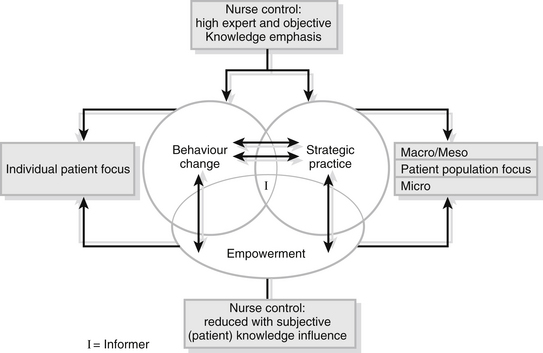Health promotion
Introduction
It is interesting to note Beattie’s (1991) observation that the major healthcare professions claim increasingly that health promotion underpins practice: interesting because while copious literature on health promotion and nursing is readily accessible in any nursing library, the emphasis tends towards practice and doing. Fundamental questions then about purpose, fit with practice and scrutiny of the different theoretical approaches and their pertinence for nursing, particularly in relation to specialist areas of practice, remain as much an underdeveloped area now as in 1991.
This debate was given fresh impetus in the UK by The Health of the Nation (HoN), the Government strategy for health in England (Department of Health 1992). This placed health promotion explicitly on the nursing agenda in general, and on the emergency care agenda in particular as accidents were one of the five key areas of the strategy with The HoN (Department of Health 1993a, p. 10) highlighting that:
Further to this, Targeting Practice (Department of Health 1993b) and Saving Lives: Our Healthier Nation (Department of Health 1999), both of which include accident prevention, emphasize how health promotion has become more of a UK NHS priority. Likewise, The NHS Plan (Department of Health 2000), Choosing Health (Department of Health 2004a), Better Information, Better Choices, Better Health (Department of Health 2004b), Benchmarks for Promoting Health (Department of Health 2006) and, for example, from an international perspective the US Healthy People 2010 (US Department of Health and Human Services 2000).
Health promotion framework
To facilitate conceptual understanding, contextualize and map out the models of health promotion Piper’s (2009) framework (Fig. 34.1), based on the work of Beattie (1991) and Piper & Brown (1998), is utilized. The framework comprises three models entitled The Nurse as Behaviour Change Agent, The Nurse as Strategic Practitioner and The Nurse as Empowerment Facilitator that derive from themes and deviant/paradigm cases generated in a qualitative study and constructive theorizing by the author to help illuminate the debate. As such, all require the tests of fit and transferability to be applied by the reader.
Similarly, when concerned with individual patient health promotion needs, The Nurse as Empowerment Facilitator converges with The Nurse as Behaviour Change Agent but is polarized on the power continuum where the former is concerned with a more bottom-up mode of intervention from an individual patient and subjective perspective. It converges with The Nurse as Strategic Practitioner when the focus of intervention is at a population level while remaining divergent in terms of the locus of control. However, given the nature of ED practice, the wider micro-population aspect of The Nurse as Empowerment Facilitator that goes beyond individual and immediate ED patient problems is not explored herein, but can be found in Chapter 8 of Piper (2009). Its concern with community development and social capital and seeking to improve health by encouraging and supporting the development of social networks and ‘social capital’ (Cooper et al. 1999) is not explored herein as this is more the domain of public health practitioners.
Operational definitions
To avoid the debate surrounding the distinction between health education and health promotion (this is explored in Piper (2009)), for the purpose of this chapter the definition of Tones (1990) is adopted. He states that health promotion: ‘incorporates all measures deliberately designed to promote health and handle diseases’ (Tones 1990, p. 3).
In addition, and consistent with Tones & Green (2004) and Piper (2009), primary, secondary and tertiary health promotion are defined as interventions that aim to:
• prevent new cases of disease or injury (primary)
• minimize the impact of disease or injury, prevent them from becoming chronic or irreversible and restore the patient to their former health status (secondary)
• maximize health experience within the context of chronic disease (e.g., diabetes, asthma, HIV), injury or disability, prevent further complications and assist rehabilitation (tertiary).
The nurse as behaviour change agent
The Nurse as Behaviour Change Agent reflects a ‘medical model’ approach to health promotion and is based on the assumption that individuals make rational, conscious decisions about their health-related behaviour. Primary interventions aim to prevent disease, illness and injury and promote optimum biological functioning by disseminating ‘factual’ information selectively derived from objective and medically based scientific research to the public. This takes the form of edicts from healthcare professionals, or the ever-present mass media awareness-raising campaigns such as the Clunk Click television car seatbelt campaigns of yesteryear, encouraging the use of cycle helmets, No Smoking Day and Drug Awareness Week, etc. It is suggested to the public that if they fail to follow a prescribed course of action their ‘health’ is at risk. The aim is to trigger a ‘do-it-yourself’ attitude and then behaviour/lifestyle changes consistent with the recommended advice given.
It is important to acknowledge that, while effective at raising awareness about particular health risks, the complexity of the relationship between social experience and health-related behaviour means that the outcomes are likely to be at best uncertain (Naidoo & Wills 2009). In emphasizing the personal controlling of risks and the correcting of individual inadequacies, it is assumed that free choice exists and that lifestyle is the primary cause of ill-health. In isolation such an approach denies that health is a social product, ignores and implicitly condones inequalities and minimal state intervention. For an excellent, albeit old and general (i.e., not related to nursing), critique of such a stance the reader is referred to Mitchell (1982); for a critique related to nursing, but not specific to ED, see Brown & Piper (1997) and Chapter 6 in Piper (2009).







